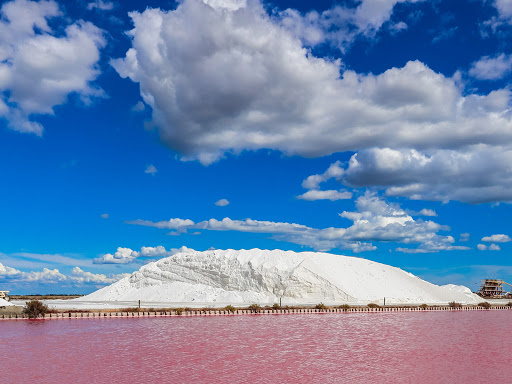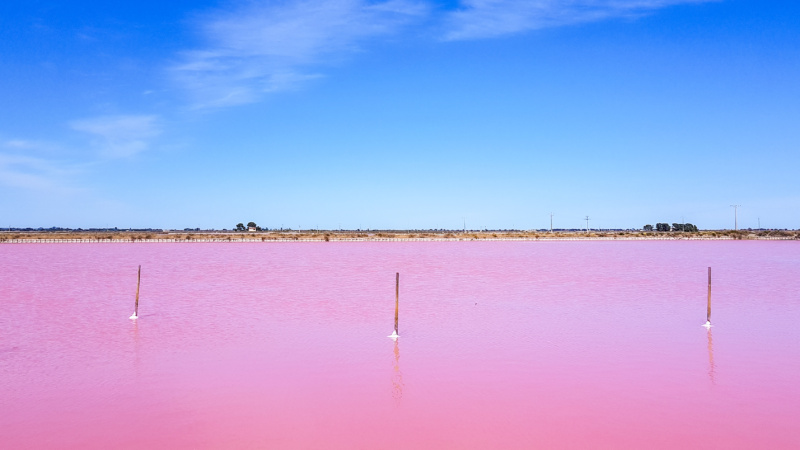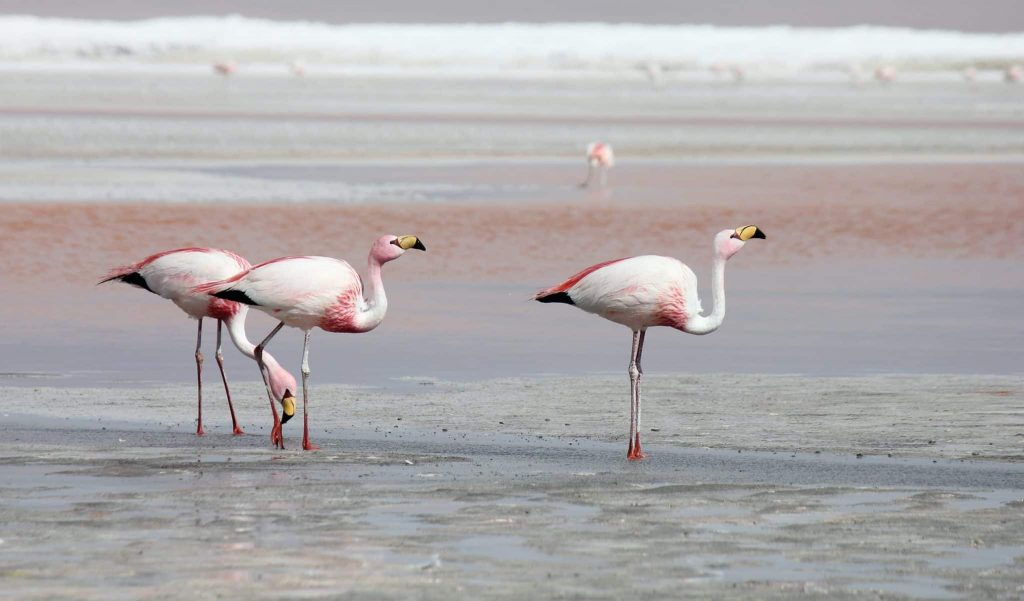All About the Salt Marshes in Aigues-Mortes
Have you ever wondered what causes the pink water in salt marshes? How did they come to be? What purpose do salt marshes serve? Why are they home to so many flamingos? We’ll cover all of that and more, as we discuss the Camargue salt marshes in the South of France. Specifically, we’re going to look at the history of the pink saltwater marshes in the medieval city of Aigues-Mortes. Keep reading to find out more.
What are the salins in Aigues-Mortes, France?



The term « salin » is French for « saline » meaning salty. In this context, a salin is a (very) large salt deposit next to a salt marsh. Located between the sandy, Mediterranean beaches near Montpellier to the West and the Rhône River to the East, the Camargue has a booming salt production industry. This is due to the very high presence of naturally-occuring salt in the soil in the Camargue, including Aigues-Mortes. Let’s take a closer look at this salty situation.
About the Salins in Aigues-Mortes, France
Aigues-Mortes is a small, fortified, medieval city located in the Camargue. The population of the city is only slightly over 8,300 people (in 2017). Literally, in French, the name « Aigues-Mortes » translates as « dead algae ». There’s a good reason for that, which we’ll get to in a moment.
Just outside of the city’s fortress walls, you’ll find over 8,000 acres of salins, composed of over 60,000 tons of salt. Each year, the region produces over 300,000 tons of salt, of which 90% is sold for direct consumption. If the « salins » are the large mountains of natural salt standing above ground, the « marais salants » are the vast, lake-like salt marshes next to them.
But perhaps most notable of all, upon seeing the salt marshes for the first time, is their appearance. The salt marshes of Aigues-Mortes are not a dark green, mucky color as you’d expect to see in a lake or any other stagnant body of water. Here, the water is pink! It’s absolutely stunning to see in real life, yes. But why is that?
Why are the salt marshes in Aigues-Mortes full of pink water?



As we mentioned above, there is a very good reason why the city of Aigues-Mortes has a name which references dead algae. It seems a little bit icky, but it’s actually very logical. In fact, the reason why the salt marshes in Aigues-Mortes (and anywhere else, for that matter) seem to be full of pink water comes down to the food chain.
The pink water comes from a pink algae (Duanaliella Salina) which lives in it. This pink algae can exist in just about any kind of natural body of saltwater. Except, the algae is not at the top of the food chain. This pink algae is the main source of nutrition for another common resident of saltwater: a miniscule shrimp called the artémias salina. But, these shrimp can only survive in certain bodies of saltwater. Once the water passes a certain level of salinity, it becomes too salty for the shrimp and they can’t survive. Which, in turn, means the pink algae takes over, no longer having a predator to keep the population down. And as a consequence, the water takes on an intense pink color from such a high presence of the algae.
And pink flamingos, too
Fun fact: This is also exactly the reason why flamingos are pink! In fact, flamingos love munching on this little shrimp. The shrimp turns pink from eating the algae, and the flamingo turns pink from eating the shrimp. Ah, the circle of life!
In Aigues-Mortes, the climatic conditions are perfect for the existence of this pink algae, and the water is too salty for the shrimp to survive. So, in turn, the salt marshes give the impression that they are full of pink water! (However, some of the other bodies of water in the Camargue region are not as salty as the salt marshes in Aigues-Mortes. This is why there are so often flamingos in the Camargue area – they come to snack on their favorite little shrimp.)



Where to Visit Other Salt Flats in the Camargue
If you’re interested in seeing some other naturally-occurring salty sights, the Camargue region in the South of France is the right place to start! Not only is the Camargue known as being a naturally beautiful area, but you’re also very likely to stumble upon some incredible wildlife in the region. The Camargue is known for its herds of wild bulls and horses, in addition to its many beautiful pink flamingos. In addition to the pink salt marshes in Aigues-Mortes, we can recommend a few other breathtaking tourist stops to consider during your journey through the Camargue.
Ornithological Park of Pont de Gau
This park specializes in the study of birds, particularly those native to the Camargue region. Of course, there is a focus on flamingos, since they’re the iconic mascot of the area. But you will also learn interesting facts about several other kinds of birds that call this natural paradise home. It makes for a unique experience as you encounter nature firsthand during your visit. You can find out more about their opening hours via their website.
Parc Naturel Régional de Camargue
This Natural Park is federally protected land, and the main mission of the park is the preservation of the natural environment that still exists there today. Visitors can take a tour of the park and visit the Camargue Museum built on the grounds. The focus of the museum is on the relationship between humans and nature in the Camargue. It is located 10 kilometers (6 miles) from the city of Arles.
Salt Pan Observation Mound
From this angle, you have the chance to take in all the beauty of the salt flats in the Camargue. The « Point de Vue du Sel, » or « Salt Perspective » in English, gives you a 360° panoramic view of the flattened earth that is leftover after the salt has been exploited from the natural marshes. The closest city to this natural wonder is Salin-de-Giraud, where you will find a large number of salt-based products, a large part of the local economy in the Camargue.


Pas de commentaire